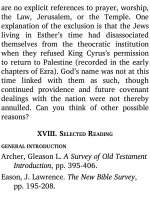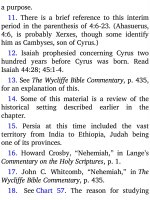Jensens survey of the old testament adam 90
Bạn đang xem bản rút gọn của tài liệu. Xem và tải ngay bản đầy đủ của tài liệu tại đây (174.05 KB, 4 trang )
outline as you read:
Chapter
Event
Significance
1
Charge to Joshua
Task identified
2
Spying Jericho
Enemy studied
3
Crossing Jordan
Leader magnified
4
Stones set up
Deliverance memorialized
5
Circumcision and Passover
Hearts prepared
2. Conquest (6:1—12:24). To possess
Canaan meant to drive out the enemy. But
the enemy was many—Hittites, Amorites,
Perizzites, Jebusites, and others—each to be
reckoned with as Joshua planned his
strategy of conquest. There is no record of
God explicitly instructing Joshua as to the
pattern of that strategy, though the divine
direction was ever present. Actually, the
geographical location of entrance into the
north-south-oriented Canaan, at Jericho,
determined the plan. See Map H for the
general movements of the central, southern,
and northern campaigns. The strategy was
simply to (1) gain the bridgehead at Jericho;
(2) extend the battle in this central region to
e ect a wedge between the northern and
southern armies; (3) then engage each, one
after the other, the nearer armies (southern)
rst. The account of the book of Joshua
follows the sequence of that plan in
recording the highlights10 of Israel’s
conquest of the enemies in Canaan. Chart 30
outlines this section of Joshua. Study the
chart as you read the Bible text.
3. Allocations (13:1—21:45). The activities
of Israel during the years of chapters 1-12
were not terminal in themselves. The
terminus was reached when it could be said
that “Joshua took the whole land” (11:23)
and that he could now divide the land “for
an inheritance to Israel according to their
divisions by their tribes” (11:23). The action
of the unhappy though necessary wars was
the prelude to the gratifying and pleasant
business of the allotment of the lands to the
Israelites.
Chart 31 shows how these chapters report
the various allocations made to the tribes
and individuals.
While there is no record of any pageantry
or colorful ceremony attending the drawing
of lots for the land assignments for each
tribe, the importance of such allotments
cannot be overstated. This was the climactic
moment in Israel’s young life, when for the
rst time she could claim a land as her own,
given by God. In the days of the patriarchs—
Abraham, Isaac, Jacob, and Joseph—the
land was too large for total claim. When by
propagation Israel grew to the size of a
formidable nation, the people were dwelling
in bondage in a foreign land, Egypt. The
wilderness years were spent on the way to
the land. The seven years of ghting after
crossing the Jordan were used to conquer
the land. Now the hour had come to claim
the land, build homes, and live with God in
peace. The day of land allotment was turly a
happy for Israel.
4 . Consecration (22:1—24:33). The rst









